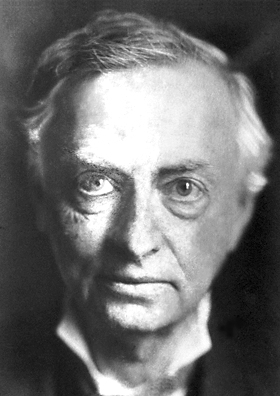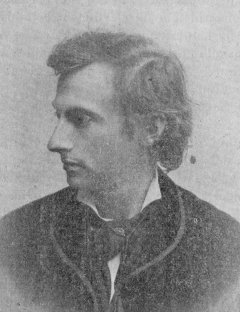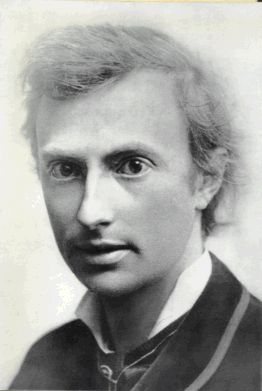<Back to Index>
- Mathematician Tibor Radó, 1895
- Writer Karl Adolph Gjellerup, 1857
- King of the Hellenes Constantine II, 1940
PAGE SPONSOR



Karl Gjellerup (June 2, 1857 – October 13, 1919) was a Danish poet and novelist who together with his compatriot Henrik Pontoppidan won the Nobel Prize in Literature in 1917. He belonged to the Modern Break - Through. He occasionally used the pseudonym Epigonos.
Gjellerup was the son of a vicar in Zealand and grew up in a national and romantic idealistic atmosphere. In the 1870s he broke with his background and at first he became an enthusiastic supporter of the naturalist movement and Georg Brandes, writing audacious novels about free love and atheism. Strongly influenced by his origin he gradually left the Brandes line and in 1885 he broke totally with the naturalists, becoming a new romanticist. A central trace of his life was his Germanophile attitude, he felt himself strongly attracted to German culture (his wife was a German) and 1892 he finally settled in Germany, which made him unpopular in Denmark on both the right and left wing. As years passed he totally identified with the German Empire, including its war aims 1914 - 18.
Among the works of Gjellerup must be mentioned his most important novel Germanernes Lærling (1882, i.e. The German Student), a partly autobiographic tale of the development of a young man from
being a conformist theologian to a pro-German atheist and intellectual.
Some Wagnerian dramas show his growing romanticist interests. An
important work is the novel Møllen (1896, i. e. The Mill), a sinister melodrama of love and jealousy. In his last years he was clearly influenced by Buddhism and Oriental culture. His work Der Pilger Kamanita/ Pilgrimen Kamanita (1906, i.e. The Pilgrim Kamanita)
has been called 'one of the oddest novels written in Danish'. It
features the journey of Kamanita, an Indian merchant's son, from
earthly prosperity and carnal romance, through the ups and downs of the
world's way, a chance meeting with a stranger monk (who, unbeknownst to
Kamanita, was actually Gautama Buddha), death, and reincarnation towards nirvana. Den fuldendtes hustru (1907, i.e. The wife of the perfect) is a versified drama, inspired by Dante's Divine Comedy, about Buddha's earthly life as Siddharta, being inhibited in his spiritual efforts by his wife, Yasodhara. The giant novel Verdensvandrerne (1910, i.e. The world roamers)
takes its contemporary starting point in a German female academic on a
study tour in India, but evolves across chronological levels, in which
characters re-experience what has happened in former eons, thus featuring souls roaming from one incarnation to another. Rudolph Stens Landpraksis (1913, i.e. The country practice of [physician] Rudolph Sten)
is set in the rural Zealand of Gjellerup's youth. The main character
develops from a liberal, superficial outlook on life, including
youthful romantical conflicts, through years of reflection and asketic
devotion to duty towards a more mature standpoint, hinting at the
author's own course of life. Das heiligste Tier (1919, i.e. The holiest animal)
was Gjellerup's last work. Having elements of self - parody, it is
regarded his only attempt of humour. It is a peculiar mythological
satire in which animals arrive at their own Elysium after death. These include the snake that killed Cleopatra, Odysseus' dog Argos, Wisvamitra (the holy cow of India), the donkey of Jesus and the horses of various historical commanders in field. The assembly select, after discussion, Buddha's horse Kantaka as the holiest of animals, but it has left without a trace to follow its master to nirvana. In
Denmark, Gjellerup's Nobel award was received with little enthusiasm.
He had long been regarded as a German writer. During various stages of
his career, he had made himself unpopular with both the naturalist left
surrounding Georg Brandes and the conservative right. His nomination for the Nobel award was,
however, supported from the Danish side for several times. Because Sweden was neutral during World War I,
the divided prize did not arouse political speculations about a partial
decision, but showed on the other hand a certain allegiance between the
Nordic
neighbors. Today
Gjellerup is almost forgotten in Denmark. In spite of this, however,
literary historians normally regard him as an honest seeker after truth. Gjellerup's
works have been translated into several languages, including German
(often translated by himself), Swedish, English, Dutch, Polish, Thai
and others. The Pilgrim Kamanita is his most widely translated book, having been published in several European countries and the United States. In Thailand, a Buddhist country, the first half of the Thai translation of Kamanita have been used in secondary school textbooks.